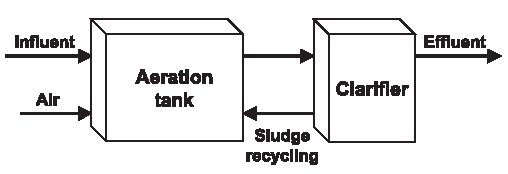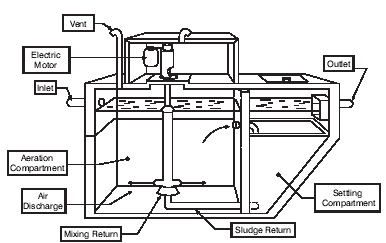


| Parameter | Extended Aeration |
| Pretreatment (If needed) Septic Tank or Equivalent | |
| Mixed Liquor Suspended Solids (mg/L) ( a ) | 2,000 - 6,000 |
| F/M Load (lb BOD/d.MLVSS) ( b ) | 0.05 - 0.15 |
| Hydraulic Retention Time (h) | 24 - 120 |
| Solids Retention Time (days) | 20 - 40 |
| Mixing Power Input ( c ) | 0.2 - 3.0 hp/1,000 ft3 |
| Clarifier Overflow Rate (gpd/ft2) | 200 - 400 avg., 800 peak |
| Clarifier Solids Loading (lb/d.ft2) | 30 avg., 50 peak |
| Dissolved Oxygen (mg/L) | >= 2.0 |
| Residuals Generated | 0.6 - 0.9 lb TSS/lb BOD removed |
| Sludge Removal | 3 - 6 months as needed |
| ( a ) : TSS in aeration tank | |
| ( b ) : Organic loading (pounds of BOD per day) to aeration tank volatile fraction of MLSS | |
| ( c ) : Power input per cubic foot of tank volume | |

| Observation | Cause | Remedy |
| Excessive local turbulence |
In aeration tank diffuser plugging Pipe breakage Excessive aeration |
Remove and clean Replace as required Throttle blower |
| White, thick, billowy foam on aeration tank | Insufficient MLSS | Avoid wasting solids |
| Thick, scummy, dark tan foam on aeration tank | High MLSS | Waste solids |
| Dark brown/black foam and mixed liquor in aeration tank |
Anaerobic conditions Aerator failure |
Check aeration systems, aeration tank DO |
| Billowing sludge washout in clarifier |
Hydraulic or solids overload Bulking sludge |
Waste sludge; check flow to unit |
| Clumps of rising sludge in clarifier |
Denitrification Septic conditions in clarifier |
Increase sludge return rate to decrease sludge retention time in clarifer Increase return rate |
| Fine dispersed floc, turbid effluent |
Turbulence in aeration tank Sludge age too high |
Reduce power input Waste sludge |
| Poor TSS and/or BOD removal | Excess flow and strength variations | Install flow smoothing system |
| Poor nitrification |
Low temperatures Excessive biocide use |
Insulate, upgrade to high biomass, etc. Reduce biocide loading |
